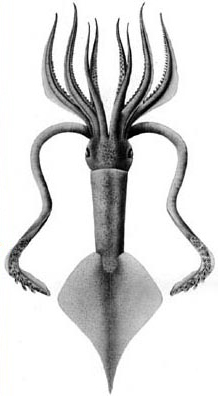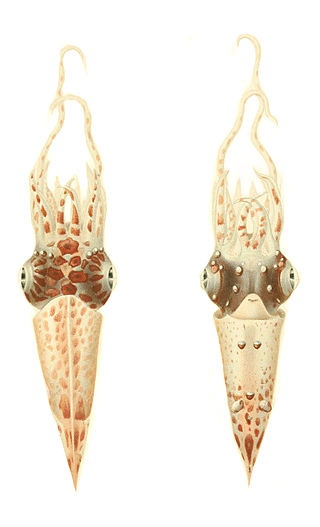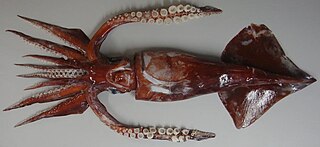
Pyroteuthidae is a family of squids. The family comprises two genera. Species are diurnally mesopelagic, migrating into surface waters during the night. The family is characterised by the tentacles, which have a permanent constriction and bend near the base; and photophores occurring on the tentacles, eyeballs, and viscera. Members reach mantle lengths of 23–50 mm. Paralarvae of the family are common around the Hawaiian Islands, with up to 17% of collected specimens in the area belonging to Pyroteuthidae.

Onykia ingens, the greater hooked squid, is a species of squid in the family Onychoteuthidae. It occurs worldwide in subantarctic oceans.

Ancistroteuthis lichtensteinii, also known as the angel clubhook squid or simply angel squid, is a species of squid in the family Onychoteuthidae and the sole member of the genus Ancistroteuthis. It grows to a mantle length of 30 cm. It lives in the western Mediterranean Sea, subtropical and tropical eastern Atlantic Ocean and western north Atlantic Ocean. Its diet include mesopelagic fish and pelagic crustaceans. It is sometimes taken as bycatch by commercial fisheries, but is not a targeted species.

Onychoteuthis banksii, the common clubhook squid, is a species of squid in the family Onychoteuthidae. It is the type species of the genus Onychoteuthis. This species was thought to have a worldwide distribution but with the revision of the genus Onychoteuthis in 2010, it is now accepted that Onychoteuthis banksii is restricted to the central and northern Atlantic and the Gulf of Mexico while a recently described species, Onychoteuthis horstkottei, is found in the Pacific Ocean. The type locality is the Gulf of Guinea.
Filippovia knipovitchi, the smooth hooked squid, is a species of squid in the family Onychoteuthidae and the sole member of the genus Filippovia. It is found in the Antarctic and Atlantic Oceans, and reaches a mantle length of 35 cm.
Onykia loennbergii, the Japanese hooked squid, is a species of squid in the family Onychoteuthidae, named by Swedish zoologist Einar Lönnberg. It occurs in the Western Pacific Ocean, at an estimated depth of 230–1200 m. The mantle length is approximately 300 mm. Each tentacular club contains 25 hooks. The arms are about 60% of the size of the mantle length.

Onykia robsoni, the rugose hooked squid, is a species of squid in the family Onychoteuthidae. It occurs in the Antarctic Ocean, at an estimated depth of 250–550 meters. The mantle of this species grows to a length of 75 cm. The species has been suggested as a junior synonym of Onykia carriboea, the tropical clubhook squid, due to similarities between the species.

Onychoteuthis borealijaponica, the boreal clubhook squid, is a species of squid in the family Onychoteuthidae. It is the largest member of the genus Onychoteuthis, reaching a mantle length of 30 cm in males and 37 cm in females. Maturity is reached at 250 mm for males, and 300–350 mm in females. There are 24–27 hooks on each club, which is more than any other species in the genus Onychoteuthis. It is a pelagic species native to the North Pacific, although it migrates into Subarctic waters during the summer from its more southerly winter spawning grounds.

Onychoteuthis compacta is a species of squid in the family Onychoteuthidae, known to occur in Hawaiian waters. as well as in other areas of the Central Pacific and western north-central Atlantic, it probably has a circumglobar distribution. The species is known to have a mantle length of at least 122 mm for females and 127 mm for males. Each tentacle has 22 club hooks, measuring approximately 30 mm in mature specimens.
Onychoteuthis meridiopacifica is a species of squid in the family Onychoteuthidae. Males become mature at 40 mm, and the species is believed to reach a maximum mantle length of 90 mm, the smallest species in the genus Onychoteuthis. The tentacular club reaches a length of 20-25% of the mantle length, and contains 16-19 club hooks. Arms reach 27-44% of the mantle length, and each contain 50-60 suckers. 8-12 nuchal folds are present on each side of the head. Its short, broad fins and the possession of a small number marginal suckers on the tentacular clubs of adults are distinguishing characteristics of this species. It is found off eastern Australia and probably extends into seas off Indonesia as well as east to Tonga and Vanuatu.
Notonykia africanae is a species of squid in the family Onychoteuthidae. It is the type species of the genus Notonykia. While the mature size of the species is unknown, it is known to reach a mantle length of at least 180 mm. Tentacles reach approximately 70% of the mantle length, and contain 14-20 club hooks. Arms are known to reach 27-45% and 33-55% of the mantle length; each containing 50-60 suckers. The species is located in southern waters off Australia, Tasmania, New Zealand and South Africa.
Notonykia nesisi is a species of squid in the family Onychoteuthidae. It is differentiated from Notonykia africanae by the shape of the tentacles. While the species is only known from immature specimens, it is known to achieve a mantle length of at least 100 mm. The tentacles are about 65-115% of the mantle length, and contain 6-18 hooks.

Pyroteuthis is a genus of squid in the family Pyroteuthidae. It is differentiated from the genus Pterygioteuthis by size, head shape and behaviour. Species within the genus are separated by the arrangement of tentacular photophores; the shape of the hectocotylus, and the shape of the hectocotylus hooks. With the exception of the Tropical Eastern Pacific, the genus is circumpolar in tropical and temperate oceans. The species P. addolux is the only member to occur in the North Pacific.

Pterygioteuthis is a genus of squid in the family Pyroteuthidae. Members are differentiated from the genus Pyroteuthis due to size and head shape. The genus is characterised by the presence of a lidded photophore over each eye.
Pyroteuthis serrata is a species of squid in the family Pyroteuthidae. It is found north of the tropical convergence in the waters around New Zealand and it does not overlap with Pyroteuthis margaritifera which has a more southerly range.

Pterygioteuthis gemmata is a species of squid in the family Pyroteuthidae.

Pterygioteuthis giardi is a species of squid in the family Pyroteuthidae. It is known as the roundear enope squid. The specific name honors the French zoologist and marine biologist Alfred Mathieu Giard (1846-1908).

The Antarctic flying squid is a species of squid from the subfamily Todarodinae of the family Ommastrephidae, a family of pelagic squid from the order Oegopsida. It has a circumglobal distribution in the seas around the lower latitudes of the Southern Ocean.
Pterygioteuthis hoylei is a species of squid in the family Pyroteuthidae. It is considered conspecific with Pterygioteuthis giardi by some authorities. It can be identified from P. giardi by having four photophores on the tentacles and many chromatophores spread along the tentacle stalk and around the aboral surface of the tentacular club. It is also slightly larger than P. giardi, it has been so far recorded only from the eastern tropical Pacific Ocean where it is the only species of in the family Pyroteuthidae to occur there, although its actual distribution may be wider than currently known. The specific name honours the British malacologist William Evans Hoyle (1855–1926).

Brachioteuthis beanii is a species of squid in the family Brachioteuthidae that lives in pelagic environments. Its young are 1.2 mm (0.047 in) in length.












